
Score breakdown
Things we like
- Immensely roomy interior including huge boot
- Improved build quality
- Content depth, presentation quality of 15-inch infotainment display
- Supercharger network
Not so much
- Noisy and restless ride
- Unremarkable range on test
- Lack of variable regen braking levels
- Restricted rear vision; no HUD
Elon Musk has promised – via Twitter, naturally – increased right-hand-drive production of the Tesla Model Y after being surprised by initial demand that pushed out delivery times rapidly from second-half 2022 to first-half 2023.
Yet, surely not even an experienced product planner would have been needed to forecast buyer response once official pricing had been confirmed for the company's most affordable SUV yet.
The Model 3 sedan on which it's based was already proving popular here before supply issues hit, and the Y has an obvious body-style advantage over the sedan.
The two vehicles are so closely related they share about 75 per cent of their parts. From front-on, it’s even tricky to tell them apart; in profile and from the rear, the Model Y looks like a Model 3 that’s been overdoing the steroids.

The Model Y is nearly six centimetres longer, touching 4.75 metres, and is seven centimetres wider. The wheelbase is stretched just 1.5cm, leaving height as the most dramatic physical difference; the top of the Y reaches an extra 18cm into the sky.
About three centimetres of that comes in increased ride height, though the Model Y is no pseudo-off-roader with its 167mm ground clearance.
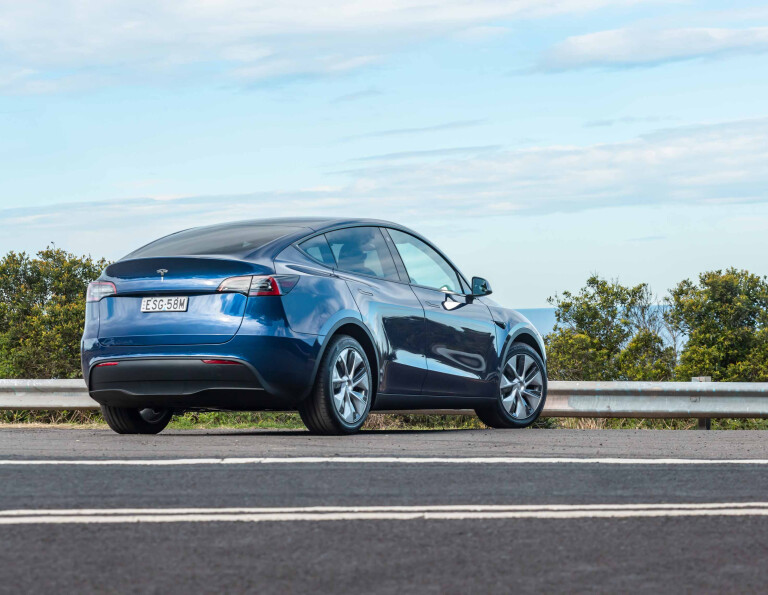
The Model 3 was already proving popular here before supply issues hit, and the Y has an obvious advantage of being an SUV rather than a sedan.
Pricing and Features
Initial pricing placed the Tesla Model Y starting point at $68,900 – $5000 above the equivalent Model 3.
However, just a week after announcing pricing, Tesla jacked the Y’s entry price to $72,300, just as delivery times were pushing out from latest-November to latest-May-2023. This increased the gap to $6800 after the base 3’s price was also increased.
While Model Y RWD buyers already missed out on $3000 rebates in NSW, Victoria and South Australia as the base model’s price was above incentive thresholds, the sudden increase was a bit naughty – with a perception, wrongly or rightly, that it was a response to big demand.
That's not to suggest there's poor value now. Spending more on the Y over the 3 brings more than a bigger vehicle with more interior space. The Model Y RWD entry variant comes with 19-inch wheels where 18s are standard on the base Model 3, as well as a 13-speaker ‘Premium’ audio that’s an option on the 3 RWD.

Shared features include electric front seats, heated seats front and rear, heated steering wheel, and full-length glass sunroof. Driver aids include blind spot detection, lane departure warning, and forward collision assist.
Options are also similar. White paint is standard, choosing black, silver, or blue (as per our test car) costs $1500, or it’s $2900 for a multi-coat red. It’s another $2900 for 20-inch ‘Induction’ alloy wheels and $1500 for a duo-tone black/white interior rather than pure black.
Old for markets such as the US but new for Australian in 2022 is a $5100 Enhanced Autopilot package, giving buyers access to a bunch of temporary-use autonomous-driving functions.
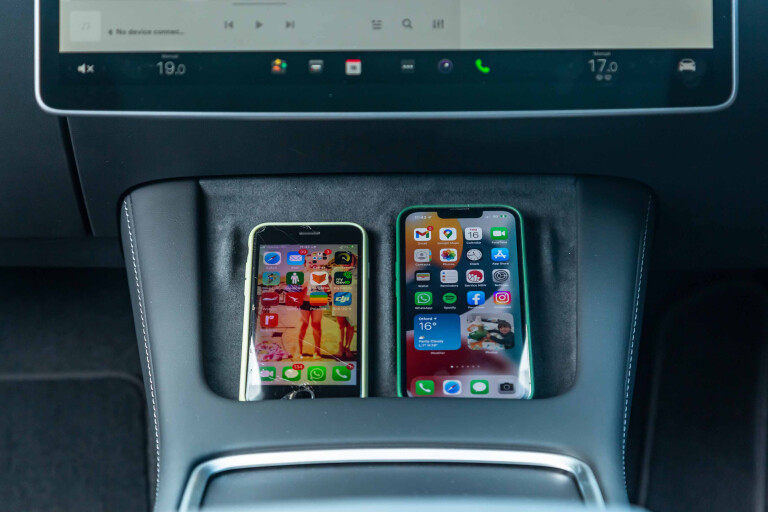
These include auto lane-changing, auto overtaking, and auto steering/accelerating/braking for freeway use, self-drive parking manoeuvres, and Smart Summon that (theoretically, at least) allows owners to bring their parked Model Y to them in a car park via the Tesla app.
Full Self Driving Capability offers all those functions plus Traffic Light and Stop Sign Control … and the enticement (when available and legal in Australia) of a properly advanced self-driving computer.
The Model Y has several direct rivals. These include the Hyundai Ioniq 5 (priced from $71,900) and our 2022 Wheels Car of the Year, the Kia EV6 (priced from $67,990).
Other models anticipated for the Australian market include the Audi Q4 E-Tron and Volkswagen ID4.

The Model Y has several direct rivals. These include the Hyundai Ioniq 5 (priced from $71,900) and our 2022 Wheels Car of the Year, the Kia EV6 (priced from $67,990).
Comfort and space
Model 3 owners switching up to a Model Y will instantly feel at home in the SUV; the interior design is shared along with platform, batteries, and drivetrains.
As befitting an SUV, however, you do sit a bit higher – a combination of 27mm extra ride height and an extra mounting base for the front seats.
The Y trades off a couple of centimetres of front legroom compared with the 3 that we can’t say was obvious – at least without a back-to-back test – though that high roofline brings headroom advantages right from the top of the windscreen.
Front occupants gain an extra 1.7cm of clearance, while there’s almost an extra layer of atmosphere for rear passengers – an increase of nearly 4.5cm.
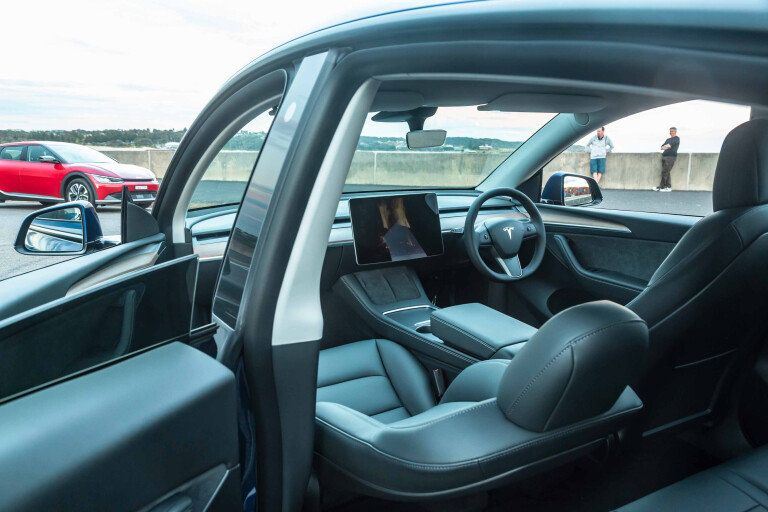
Legroom increases by a whopping 13.5cm, achieved with revised packaging that also takes advantage of a slightly longer wheelbase (by 1.5cm) as well as that slightly shortened front legroom.
Unlike the Model 3, the Y’s rear seats also offer a choice of two recline positions (though the EV6 and Ioniq 5 provide a greater range of seatback tilting).
Shoulder room is virtually unchanged and hip space shrinks by 4.5cm despite the Y puffing out by about 7cm in width, according to Tesla’s specs.
A completely flat floor still makes the middle seat viable for an adult, if still the short straw for journeys.

An impressive tinted sunroof spans virtually the entire roof, a seamless expanse of glass where the model 3’s roof features a middle beam. The glass features UV protection, while accessory sunshades are available for owners concerned about particularly hot days.
A 7-seater version of the Model Y is available in markets such as the US but is an unknown for Australia (yes, we tried asking!). However, US reviews point to the third row being all but unuseable.
Arguably the biggest reason Model 3 owners are being tempted into the Y, or first-time Tesla buyers will pick the SUV, is found in the boot.
Opening the automatic tailgate immediately reveals a far larger aperture than the relatively narrow – though far from impractical – opening of the Model 3’s boot.
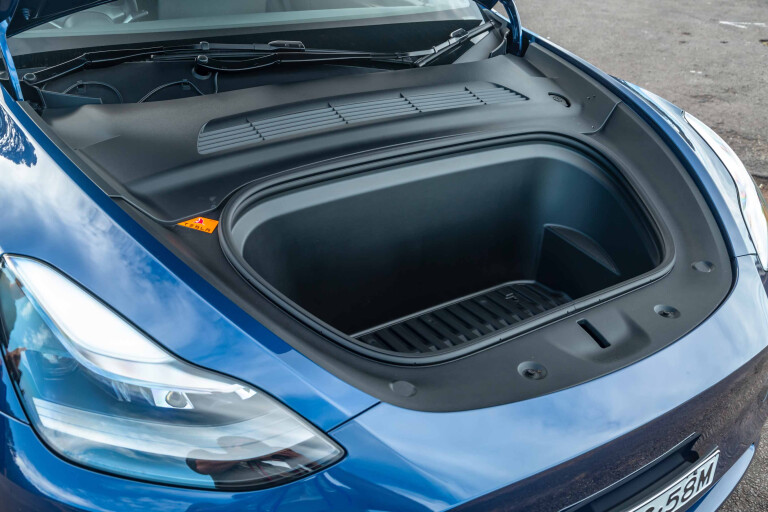
Quoted luggage capacity is a vast – and unrivalled – 854 litres (measured to the roof); a 52 per cent increase over the 3’s 561L boot. In both cases, these figures include underfloor storage.
This is more again in the Y – where it features a larger/wider tub nearest the boot opening, while adding an extra, shallower underfloor section behind that is useful for cables.
Another bonus is two electric release switches, which you hold to fold down the 60-40 rear seats – completely flat. The middle seatback can be flattened individually for a ‘ski trip’ set-up.
Unlike the Model 3, then, the Y will accommodate mountain bikes inside. Or, alternatively, opt for the Roof Rack accessory.
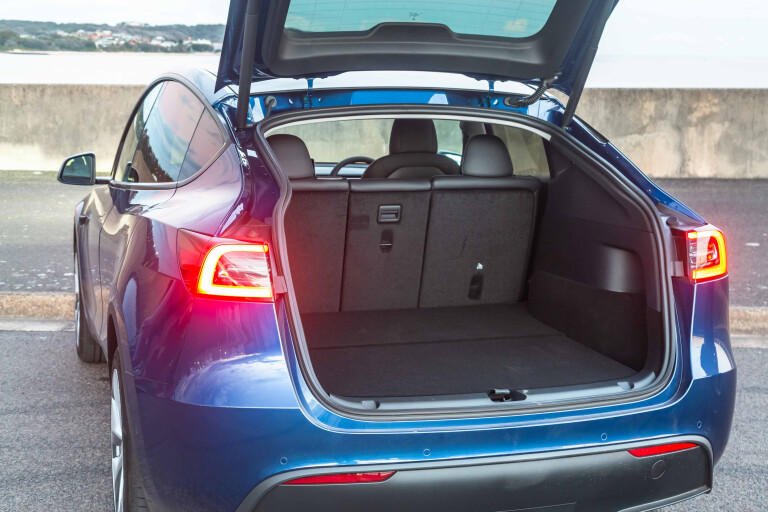
Up front, there’s a 117-litre ‘frunk’ under the bonnet – not just larger than the version in the Model 3 (88L) but also more than double the volumes quoted for the EV6 and Ioniq 5 (52L and 54L, respectively)
A 7-seater version of the Model Y is available in markets such as the US but is an unknown for Australia (yes, we tried asking!). However, US reviews point to the third row being all but unuseable.
Back to the cabin, and our test car had the best build quality we’ve experienced yet in a Tesla. Where we’ve always found loose bits of trim, or misaligned joins, everything felt encouragingly tight.
The long, Scandi-inspired wood across the dash and suede-panelled doors lift perceived quality.
The 15-inch central touchscreen shared with the 3 also stands out in that ultra-minimalist dash.
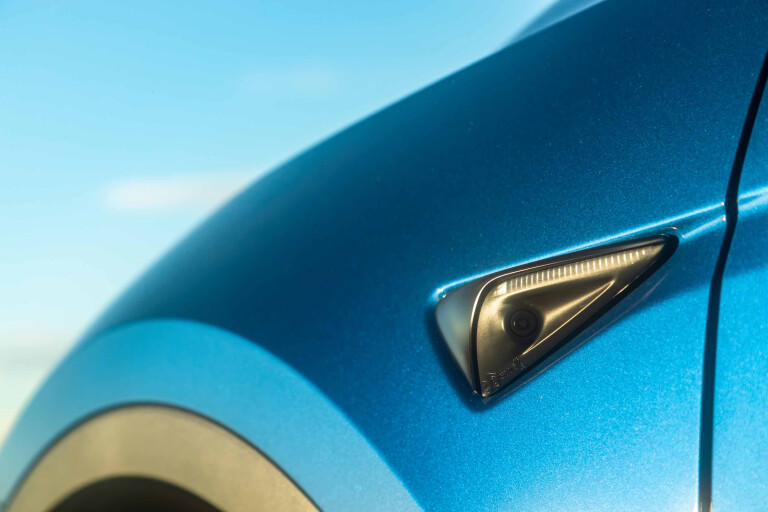
While previous Tesla owners will get to grips with this display that hoards virtually all car functions, it can be daunting for first-timers – especially as all driving information including the speedo is on the screen.
As with other Teslas, familiarity doesn’t prevent the touchscreen from being a distraction at times on the road, as eyes are averted to press various icons or words that can be quite small.
A head-up display would do wonders for this vehicle.
The design, layout and response are all impressive, though, as is the amount of entertainment options available. There’s an assortment of games, and you can even stream Netflix or YouTube.
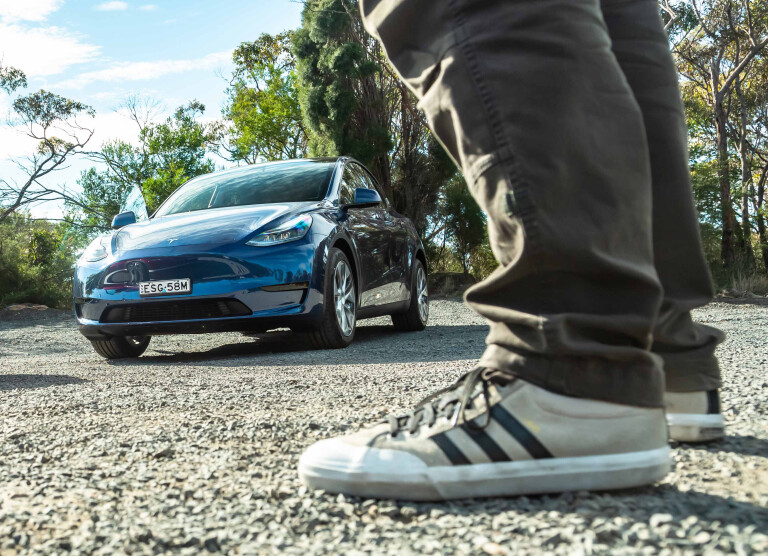
After a 30-day complimentary subscription, owners just need to pay a monthly ($9.99) subscription to retain some of those features. (Sorry, there’s no Wordle feature yet.)
The standard Premium audio system also sounds excellent.
You can also expect the infotainment system to be constantly upgraded via Tesla’s over-the-air updates (though a major update in late 2021 was a mixed result for functionality).
Again, as with the 3, the Y features not one but two charging trays for smartphones, and they’re neatly positioned/angled below the dash.
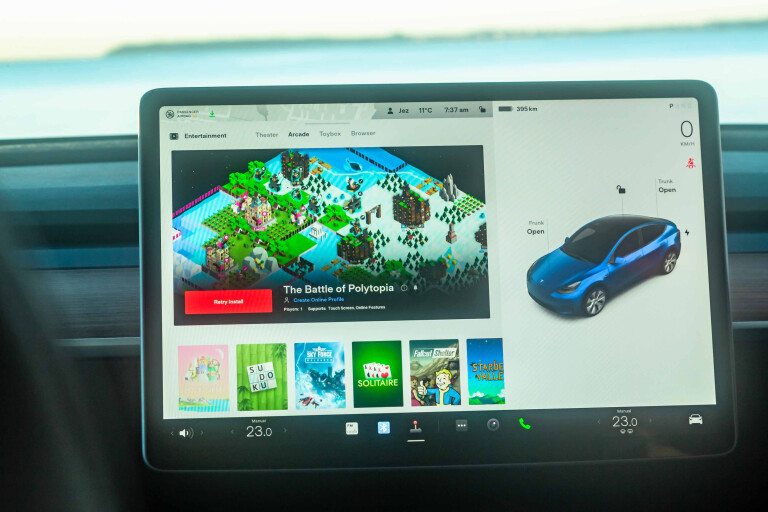
On the road
It’s easier to discover the recipe for KFC’s secret sauce than battery and power specs for Teslas, so some presumptions and estimates are needed for the Model Y RWD.
One presumption is that it uses the same circa-60kWh Lithium Iron Phosphate (LFP) battery found in the base Model 3, while power/output estimates are 220-240kW and 400-420Nm, based on varying sources.
This makes sense based on the official specs Tesla does provide, as the Model Y RWD is slower and more range limited than the equivalent Model 3 that is 157kg lighter.
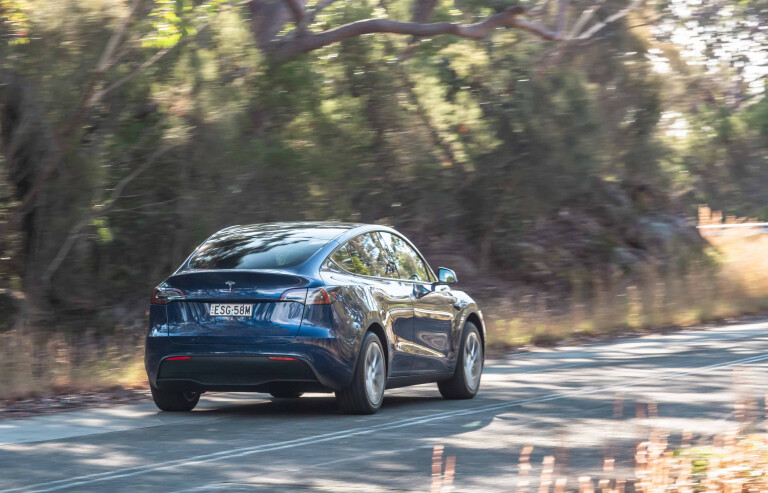
According to Tesla, the Model Y can accelerate from 0-100km/h in 6.9 seconds. While that’s slower than the 6.1 seconds of the Model 3, proper perspective comes from comparing rivals.
Rear-drive versions of the EV6 and Ioniq 5, for example, have claims, respectively, of 7.3 and 7.4 seconds.
A much faster Model Y is available with the all-wheel-drive Performance variant, which has a claimed 0-100km/h time of 3.7 seconds. It needs to be a major buying priority, though, as the Performance costs about $110,000 on the road.
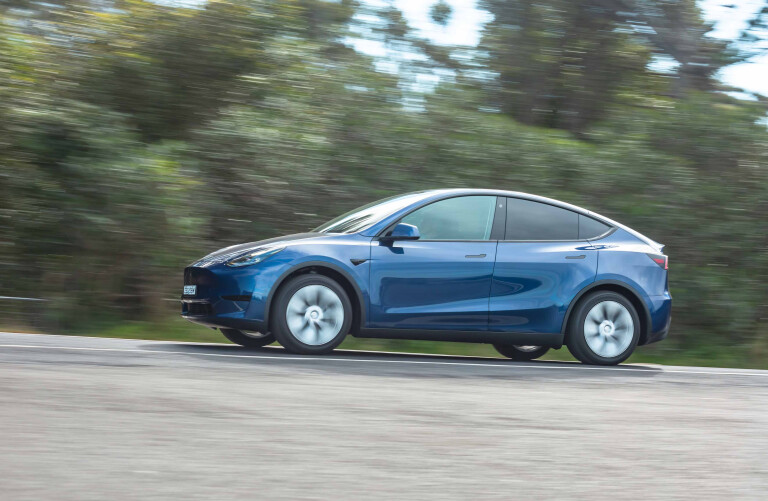
According to Tesla, the Model Y can accelerate from 0-100km/h in 6.9 seconds. While that’s slower than the 6.1 seconds of the Model 3, proper perspective comes from comparing rivals.
The more important figure for EV buyers/owners is range. And, here, the Model Y RWD has a WLTP-rated maximum range of 455km. That’s below the 491km of its sedan relative, fractionally ahead of the Hyundai’s 451km, but well short of the EV6 RWD’s 528km.
The Model Y Performance has a WLTP range of 514km, while a Long Range variant available overseas but not yet confirmed for Australia serves up a maximum 533km.
EVs are not renowned for ever achieving those lab-derived range estimates, though we were surprised when our testing pointed to a theoretical maximum range of only 335km after our longest drive of the Model Y.
This incorporated about 200km of mostly suburban roads, with some country roads thrown in, and only minimal freeway driving.

The biggest issue with the Model Y, however, is ride quality. It’s not deal-breaking poor, but it’s certainly not good. The Model 3 is no paragon of smoothness, but the Y’s larger wheels and heavier body compound the suspension’s lack of compliance.
Not only does the Model Y struggle to settle, regardless of surface, but suspension noise can be intrusive.
We’ve yet to test the optional 20-inch wheels, which could further exaggerate the ride issues.

EVs are not renowned for ever achieving those lab-derived range estimates, though we were surprised when our testing pointed to a theoretical maximum range of only 335km after our longest drive of the Model Y.
Unless you’ve previously driven a Model 3, the ridiculously quick steering – barely two turns lock to lock – can take time to get accustomed to; the front end is reactive to just a small movement of the steering wheel off centre.
This makes the Model Y highly responsive on twisty roads, though the steering is numb even if you choose the Sport mode that adds extra resistance to the wheel. Comfort is the lightest setting, though we’d be happy sticking permanently with the default Standard weighting.
At least the steering wheel is still round, with Tesla’s ‘yoke’ thankfully not migrating from the Model S Plaid.
While Tesla has widened the Model Y’s tracks to help counter the SUV’s higher centre of gravity, it doesn’t feel as composed in corners as the Model 3.

Keen drivers will derive much greater satisfaction from the EV6, which delivers superior ride comfort, especially in base Air form, and a generally more fluid and relaxing motoring experience.
This extends to throttle pedal usage. In late 2020, Tesla inexplicably – because the company doesn’t operate a PR department – deleted a choice of Standard and Low settings for its regenerative braking system.
The Low mode made for less aggressive deceleration when lifting off the throttle pedal.
Standard, which is stronger and better for harnessing the kinetic braking energy that is turned into electrons to partially replenish the vehicle’s battery, is now the default.
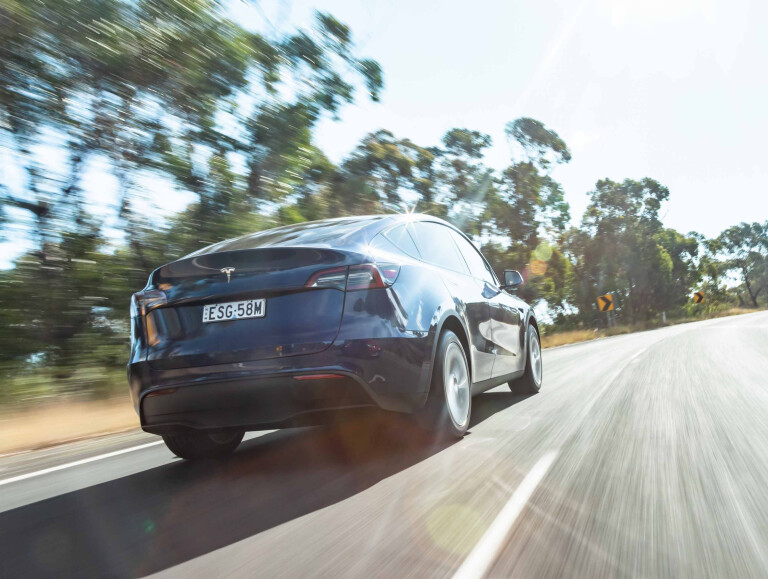
Even for EV newbies, it shouldn’t take long to feel instinctive. It also delivers one-pedal driving, though maintaining a set speed asks a bit more effort from your right calf muscle than in the EV6 or Ioniq 5 that offer four different levels of regen braking (which can be conveniently adjusted by paddle levers behind the steering wheel).
The Model Y RWD’s acceleration undoubtedly feels slower than the Model 3’s, yet the SUV remains sufficiently, and enjoyably, brisk.
The front seats are comfortable and the view forward is better compared with the Model 3, though the Model Y’s rear vision is very narrow and the side mirrors are smaller than on the average midsized SUV.
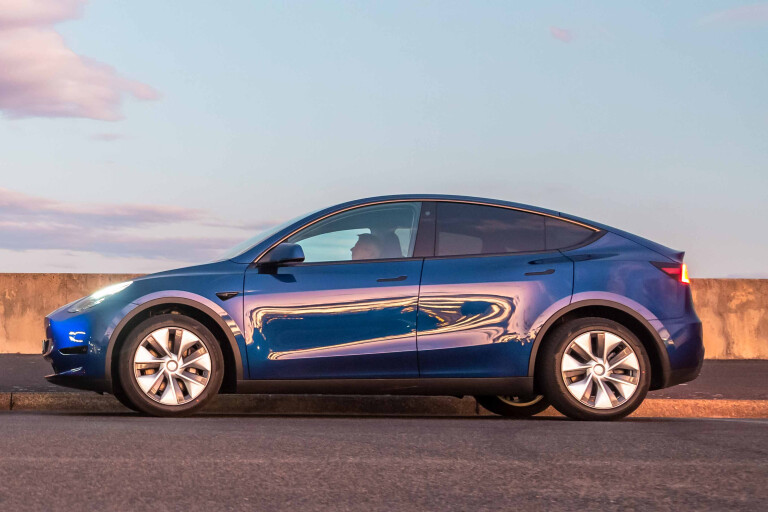
Recharging
The Model Y lacks the super-rapid, 800V charging capability of the EV6 and Ioniq 5, but Tesla provides a bigger real-world benefit – an established network of Superchargers that gives owners greater confidence to venture out on long drives.
The company says it’s possible to add up to 261km of range in just 15 minutes.
The Model Y can also be recharged via CCS ports that most other EVs utilise.
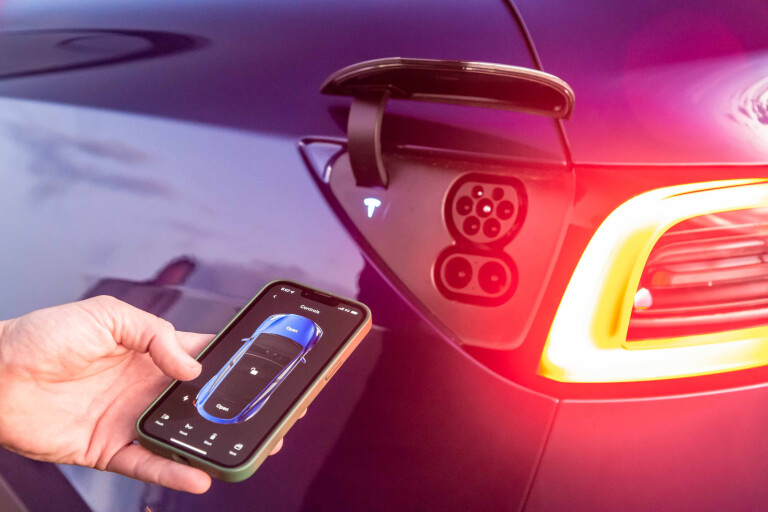
Invest $780 in a Gen 3 Wall Connector (not including installation costs), and Tesla says you can add about 71km per hour of charging.
It’s also worth noting that for models equipped with an LFP battery (such as the Model Y RWD), Tesla recommends sticking to a 100 per cent charge limit and fully charging the vehicle at least once a week.
Tesla recommends charging to 90 per cent for its AWD models – such as the Model Y Performance – which use a different, Nickel Cobalt Aluminium Oxide (NCA) battery.

Ownership
Tesla vehicles come with a general four-year/80,000km warranty, with an eight-year/160,000km warranty applied to the battery and drive unit.
The Tesla app is a key pillar of ownership, offering a level of smartphone-based functionality currently unrivalled.
It's possible to make the key card redundant by connecting it to your phone, then using the lock/unlock function (otherwise entry is achieved by 'scanning' the car against the B-pillar).
You can press the respective parts of a birds-eye graphic of the car to open the tailgate or frunk, pre-heat or pre-cool the car before you get to it, and monitor battery life.
This writer's favourite feature is Location, which provides a map guide to the nearest Tesla Supercharger - select your choice and you can then send the route instructions direct to the Model Y's navigation on the centre display.
Tesla vehicles come with a general four-year/80,000km warranty, with an eight-year/160,000km warranty applied to the battery and drive unit.
Roadside assistance is complimentary under the main warranty, covering towing (and transport costs up to 800km) in the event of a malfunction, lockouts, and flat tyres.
The latter will be needed if you get a puncture as the Model Y doesn’t come with a spare wheel – and an optional tyre repair kit no longer appears to be available.

VERDICT
It's no big shock that the Model Y feels very much like a bigger Model 3, yet justifying its higher premium almost entirely with interior space that is not only more substantial than the sedan's but unrivalled in its segment.
And against rival EVs, the appeal of Tesla's relatively expansive Supercharger network – in what is otherwise a lacklustre EV infrastructure in Australia – can't be underestimated. We just hope owners will manage to extract more range from their Model Y than we did on test.
Ultimately, though, it's the SUV's lack of dynamic polish that means the Model Y doesn't stand out for class leadership like its close relative, the Model 3.
2022 Tesla Model Y specifications
| Body | 5-door SUV |
|---|---|
| Battery | 60.0-62.3kWh (estimated) |
| Drive | RWD |
| Electric | motor Single, rear |
| Transmission | Single-speed reduction gear |
| Power | 220kW (estimated) |
| Torque | 420Nm (estimated) |
| 0-100km/h | 6.9 seconds (claimed) |
| Range | 455km (WLTP) |
| Weight | 1909kg |
| Suspension | Double wishbones, coil springs (f) / multi-links, coil springs ® |
| L/W/H | 4751/1921/1623mm |
| Wheelbase | 2890mm |
| Brakes | 355mm ventilated disc front / mm solid disc rear |
| Tyres | Hankook Ventus S1 Evo 3 (255/45R19) |
| Wheels | 19-inch wheels |
| Price | $72,300 + on-road costs |
Score breakdown
Things we like
- Immensely roomy interior including huge boot
- Improved build quality
- Content depth, presentation quality of 15-inch infotainment display
- Supercharger network
Not so much
- Noisy and restless ride
- Unremarkable range on test
- Lack of variable regen braking levels
- Restricted rear vision; no HUD



COMMENTS